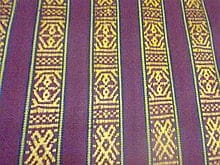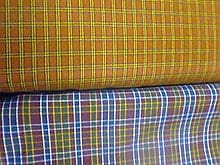Bhutanese textiles represent a rich and complex repository of a unique art form. They are recognised for their abundance of colour, sophistication and variation of patterns, and the intricate dyeing and weaving techniques. The weavers, who are mostly women, must not be seen merely as creator of wealth but also as the innovators and owners of artistic skills developed and nurtured over centuries of time.
For centuries, the Bhutanese have been wearing the beautiful and delicate textiles. As the textile production moves beyond the confines of clothing to the artistic expression of individuals and communities, patronage from the royal household is vital. The role and the influence of royal women in sustaining and promoting the weaving tradition are very important.
THE BHUTANESE ART OF WEAVING:
Thagzo – The art of weaving is an essential part of Bhutan’s cultural heritage in the thirteen traditional arts and crafts that have been practiced from the immemorial time. The textile shows a side of the Bhutan culture in vibrant colours, sophisticated patterns and the intricate dyeing and weaving techniques. These complicated techniques have been developed and practiced widely for ages, throughout the history of the kingdom.
The Patterns:
Plain weaves:
Plain weave textiles are usually woven in patterns with stripes and plaids.
Martha: Plaid weave usually with red or maroon as the dominant color.
Sertha: Plaid weave usually with yellow or orange as the dominate color.
Thara: Woven only for production of horizontal striped Kira with white as the dominate color.
Kamtham Jardrima: Striped weave incorporating the colors of the rainbow.
Warp Pattern Weaves:
Warp is the yarn that runs lengthwise on the loom. The warp pattern designs are characterized by their supplementary warp floating technique that forms bands of repeated motifs on ground. The different warp pattern designs are differentiated with their color schemes. The number of legs or cross hatches in each supplementary warp pattern band is one indicator of the superiority of the textile. The textile is even more priced when the weaver includes weft pattern designs.
Mentsi Martha: Alternate yellow warp bands with plain weave red ground.

(Mentsi martha)

Sertha (top) Martha (bottom)
Lungserma: Alternate green red on yellow ground.
Dromchuchem: Literally means ‘with little boxes’ pattern bands are woven in threes.
Mentha: Narrow white warp bands on black ground. It is the one pattern which is worn solely by women.
Weft: Yarn that is passed back and forth through each shed across the loom and is interwoven with the wrap.
Weft Pattern Weaves:
Weft patterns are popularly referred to as Sapma continuous weft patterns and Tigma discontinuous weft patterns in Bhutan. The continuous weft patterns are very similar to those featured in other textile throughout South and Southeast Asia. The weft yarn is inserted between intervals of the warp yarn to create continuous weft patterns. The discontinuous weft patterns motifs resemble embroidery are indigenous to Bhutan. Colored pattern yarns are knotted individually to the weft yarns to create geometric motifs which are usually combination of multiple pattern motifs.
Sapma: Continuous weft pattern designs.
Tingma: Discontinuous weft pattern designs. Textile experts often mistake the supplementary weft pattern designs for embroidery as they say it is impossible to weave the brocade patterning on a common back-strap loom.
The sapma and Tingma weft pattern designs are usually used as pattern designs for :
Ngoshom: Kira with the dark ground usually blue or black.
Kushuthara: Kira with a white ground.
Shilochem: Woven both for Gho and Kira, usually woven with alternate rows of wrap pattern bands.
Traditional Clothing:
Bhutan’s traditional dress is one of the most distinctive and visible aspects of the country. It is compulsory for all Bhutanese to wear national dress in schools, government offices and on formal occasions. Men, women and children wear traditional clothing made from Bhutanese textiles in a variety of colourful patterns.
The Bhutanese pride themselves in the art of creating these beautiful and unique textiles. They wear these textile clothes almost every day. Bhutan government has made the national dress the standard to be worn during official setups (men wear Gho, women wear Kira), giving the people a unique identity. In almost every Bhutanese house, you can come across some connections to a weaver or weaving.
Gho and Kira:
Men:

(Gho)
A gho is a long robe similar to the Tibetan Chuba. It is knee length and to hold it in place, they use a woven cloth belt called a kera. The kera is wound tightly around the waist, and the large pouch formed above it is traditionally used to carry a bowl, money and the makings of doma.
Ghos come in a wide variety of patterns, though often they have plaid or striped designs. Flowered patterns are taboo, and solid reds and yellows are avoided because these are colours worn by monks; otherwise patterns have no special significance. Historically, Bhutanese men wore the same thing under their gho that a true Scotsman wears under his kilt, but today it’s usually a pair of shorts. In winter it’s correct to wear thermal underwear, but it’s more often a pair of jeans or a tracksuit.

(Kabney)
For formal occasions or even while visiting the dzong (fort-monastery), they wear a scarf called a kabney that identifies a person’s rank.
The kabney has to be put on correctly so it hangs in exactly the right way.
Ordinary male citizens wear a kabney of unbleached white silk and each level of official (male or female) wears a different coloured kabney: saffron for the king and Je Khenpo; orange for lyonpos; blue for National Council and National Assembly members; red for those with the title Dasho and for senior officials whom the king has recognised; green for judges; white with a central red stripe for dzongdags (district governors); and white with red stripes on the outside for a gup (elected leader of a village).
Footwear:
Traditional footwear is knee-high, embroidered leather boots, but these are now worn only at festivals. Most Bhutanese men wear leather shoes, trainers or trekking boots. Other than that, Tsoglham is the traditional shoes for men in bhutan. They contain enormous significance. It is said that, when a man wears Tsog lham, he can visit any Lhakhang throughout the country.
Women:

Women wear a long floor-length dress called a kira. This is a rectangular piece of brightly coloured cloth that wraps around the body over a Tibetan-style silk blouse called a wonju. The kira is fastened at the shoulders with elaborate silver hooks called koma and at the waist with a belt that may be of either silver or cloth. Over the top is worn a short, open, jacket-like garment called a Toego. Women often wear large amounts of jewellery. The whole ensemble is beautiful and Bhutanese women are very elegant in their finery.
The kira may be made from cotton or silk (usually synthetic these days) and may have a pattern on one or both sides. For everyday wear, women wear a kira made from striped cloth with a double-sided design, and on more formal occasions they wear a kira with an embellished pattern woven into it. The most expensive kiras are kushutaras (brocade dresses), which are made of hand-spun, handwoven Bhutanese cotton, embroidered with various colours and designs in raw silk or cotton thread. Lhuentse is celebrated for its kushutara designs.
When visiting dzongs, women wear a cloth sash called a rachu over their shoulders or simply over their left shoulder in the same manner as men wear a kabney.
Rachu:

It is similar to the Kabney of men in which some of Rachus are in different colors representing women’s position. Normally, most Bhutanese women wear red Rachu with intricate design, it is always draped on the left shoulder on special occasions.
Traditional costumes symbolizes the essence of fascinating Bhutan through the ups and downs of the historic journey. One of the crucial elements making Bhutan a treasure on the eastern slope of the Himalayas is the hand-woven traditional dresses, they create a deep understanding of the unique Bhutan culture as well as the custom of the country.
Reference:
Wikipedia contributors. (2019, December 26). Textiles of Bhutan. Retrieved from https://en.m.wikipedia.org/wiki/Textiles_of_Bhutan
Planet, L. (n.d.). 355819: Retrieved from https://www.lonelyplanet.com/bhutan/background/other-features/the-bhutanese-way-of-life/
Bhutan Traditional Dress – National Costume | Go. (2020, March 3). Retrieved from https://www.gobhutantours.com/bhutan-traditional-dress-national-costume/
designthemes. (2019, June 13). Textile in Bhutan – The Bhutanese art of weaving. Retrieved from https://www.bhutanpelyabtours.com/textile-in-bhutan-the-bhutanese-art-of-weaving/

